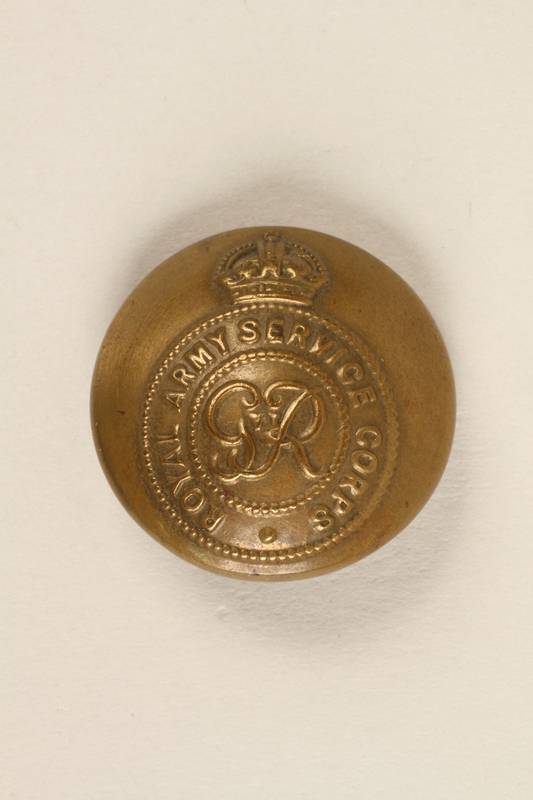Overview
- Brief Narrative
- Button with the Royal Coat of Arms which a British soldier pulled off his greatcoat and gave to 12 year old old Joseph Schadur on May 16, 1940, in Le Parcq, France. Joseph and his family had just fled Belgium following the Germany invasion.They stopped to consider their route in Le Parcq where they met a large number of British troops. When Joseph's father told one soldier that he was thinking of going toward Dunkirk on the coast, the soldier advised him to go south. He gave him gasoline saying that he did not need it since they were heading across the Channel. Joseph's father, Michel, left Germany in 1935 because the Nazi government's anti-Jewish policies were making it dangerous to live there. His wife, Manja, their 2 children, Joseph and his 4 year old sister, Benita, and his mother joined him in Antwerp, Belgium, in January 1936. After the Germans occupied Belgium in May 1940, the family was forced to flee once more. Traveling by private car, they eventually made their way to Lisbon, Portugal. They sailed for New York on board the SS Exeter on February 21, 1941.
- Date
-
received:
1940 May 16
emigration: 1941 February 21
- Geography
-
received:
La Parcq (France)
- Credit Line
- United States Holocaust Memorial Museum Collection, Gift of Joseph Shadur
- Markings
- front, innermost circle, stamped : G / VI / R [for King George 6th)
front, outer circle, stamped : ROYAL ARMY SERVICE CORPS
back, around border, stamped : FIRMIN & SONS LTD ˑ LONDON ˑ - Contributor
-
Subject:
Joseph Shadur
- Biography
-
Joseph Schadur was born on April 23, 1928, in Riga, Latvia, to Manja (Masha) Hasenson and Michel Schadur. His parents moved to Berlin, Germany, in 1927, shortly after their marriage on June 12, but his mother returned to Riga for Joseph’s birth to be with her family. He had one sister, Benita, born in Berlin in 1932. They were not a particularly religious family, and attended synagogue only on theJewish high holidays. His father worked in the wholesale fruit industry. He travelled widely and was fluent in several languages. Hitler came to power in 1933, and by 1935, Michel’s business began to decline due to antisemitic boycotts and restrictions. That year while in Belgium on business, Michel decided not to return to Germany. With much difficulty, Manja obtained temporary tourist visas and she and the children joined him in Belgium on January 1, 1936. Michel was able to re-establish his business. The children attended a Tachkemonia Orthodox Jewish kindergarten and boys’ school. Joseph later transferred to a private French school. They spent the summer months at a children’s home in Oostduinkerke, where they explored the dunes and the bulwarks that remained from World War I.
In May 1940, Germany occupied Belgium, and the family had to flee once more. They left by private car and reached Bordeaux before the French surrender to Germany in late June. For seven months, they managed to get by in Bruges, a country village near Bordeaux. With the assistance of Joseph’s maternal aunt, Gitta, who had emigrated from Germany to the United States in 1939, they received immigration and transit visas. The family left for the Spanish border on December 14, 1940. After two month in Lisbon, Portugal, they sailed on the SS Exeter to New York on February 21, 1941. From there, they proceeded to St. Paul, Minnesota, where Gitta and other relatives had already settled. The family changed their last name to Shadur.
Michel returned to Europe for a few years in the immediate postwar period to work for UNRRA, the United Nations Refugee Relief Association, chiefly at Backnang displaced persons camp. Joseph attended the University of Minnesota. In 1950, he moved to Israel where he married Yehudit, who would become an internationally recognized artist for her rediscovery of the art of Jewish paper cutting. Joseph passed away, age 77, in October 2005.
Physical Details
- Language
- English
- Classification
-
Tools and Equipment
- Category
-
Fasteners
- Object Type
-
Metal buttons (lcsh)
- Physical Description
- Circular, copper allloy button. The front has an embossed crown atop a beaded double circle design. In the outer circle is English text; the inner circle has 2 scripted English letters with Roman numerals between. The back has a lug that goes through 2 holes in the center and English text around the border.
- Dimensions
- overall: Height: 1.000 inches (2.54 cm) | Width: 1.000 inches (2.54 cm) | Depth: 0.630 inches (1.6 cm)
- Materials
- overall : metal
Rights & Restrictions
- Conditions on Access
- No restrictions on access
- Conditions on Use
- No restrictions on use
Keywords & Subjects
Administrative Notes
- Legal Status
- Permanent Collection
- Provenance
- The button was donated to the United States Holocaust Memorial Museum in 2005 by Joseph Shadur.
- Record last modified:
- 2023-08-31 14:42:48
- This page:
- https://collections.ushmm.org/search/catalog/irn517558
Download & Licensing
In-Person Research
- By Appointment
- Request 21 Days in Advance of Visit
- Plan a Research Visit
- Request to See This Object
Contact Us
Also in Michel Shadur family collection
The collection consists of artifacts, books, documents, and photographs relating to the experiences of Michel Schadur and his family as they escaped from Nazi Germany to Belgium, then to France, Spain, Portugal, and finally the United States during the Holocaust.
Date: 1920-1960
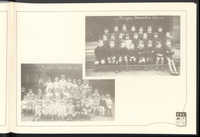
Shadur family papers
Document
The Shadur family papers document the experiences of Michael Shadur and his family, including their relocation to Belgium after antisemitic boycotts began to undermine his family business in Berlin, and following the German invasion of Belgium in 1940, their subsequent escape through France, Spain, and Portugal before immigrating to the United States. The contents of the papers contain various documents of Michael and Manya Shadur, their children Joseph and Benita, and their extended family. These include travel documents, identification materials, school notebooks and report cards, and other various material. Also included are photographs, records concerning Michael’s time serving with the United Nations Relief and Rehabilitation Administration, and publications such as newspapers and road maps used by the family as they drove to Portugal. The Shadur family papers primarily contain documents kept by Michel and Manya Shadur, and their children Joseph and Benita, during their time in Belgium and France. Included in Michel and Manya’s records are identification materials, such as passports and travel permits, birth and marriage certificates, and automobile registration. Other items include correspondence with family members, diplomas, and Michel’s editorialized account of his journey written by a reporter soon after arriving in the United States, entitled The Story of my Flight for Refuge. The records pertaining to Joseph and Benita Shadur are mainly school related, such as notebooks and report cards. There are also booklets that contain sketches made by Joseph. The documents pertaining to extended family include various material related to Michel’s sister Sonja and her family, and Manya’s brother-in-law Jacob Chankin. The bulk of material relates to Michel’s other sister Gitta, and contain personal papers, passports, and correspondence from her time in Italy and while she lived in the United States. The United National Relief and Rehabilitation Administration (UNRRA) series relates to Michel’s work with the UNRRA, and includes correspondence, letters of recommendation, re-assignment orders, and various other material. The photographs are of the Shadur’s and extended family, and are from their time from Riga, Germany, Belgium, France, and the United States, as well as Michel’s work with the UNRRA. The publications series contains a souvenir book from Bruges, France, road maps the family used as they traveled to Lisbon, newspaper clippings, and Joseph Shadur’s memoir, A Drive to Survival.
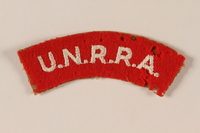
UNRRA red felt patch with acronym worn by a refugee aid worker
Object
Patch worn by Michel Shadur when he worked for the United Nations Relief and Rehabilitation Administration (UNRRA) in Germany from 1945-1947. He worked as a supply officer for the Wurttemburg district and as director of a displaced persons camp for Jewish refugees in Backnang. Michel left Germany in 1935 because the Nazi government's anti-Jewish policies were making it difficult and dangerous to live and work there. His wife, their 2 children, 8 year old Joseph and 4 year old Benita, and his mother joined him in Antwerp, Belgium, in January 1936. However, after the Germans occupied Belgium in May 1940, the family was forced to flee once more. Traveling by private car, they eventually made their way to Lisbon, Portugal. They sailed for New York on board the SS Exeter on February 21, 1941.
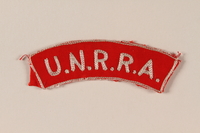
UNRRA red cloth patch with acronym worn by a refugee aid worker
Object
Patch worn by Michel Shadur when he worked for the United Nations Relief and Rehabilitation Administration (UNRRA) in Germany from 1945-1947. He worked as a supply officer for the Wurttemburg district and as a director of a displaced persons camp for Jewish refugees in Backnang. Michel left Germany in 1935 because the Nazi government's anti-Jewish policies were making it difficult and dangerous to live and work there. His wife, their 2 children, 8 year old Joseph and 4 year old Benita, and his mother joined him in Antwerp, Belgium, in January 1936. However, after the Germans occupied Belgium in May 1940, the family was forced to flee once more. Traveling by private car, they eventually made their way to Lisbon, Portugal. They sailed for New York on board the SS Exeter on February 21, 1941.
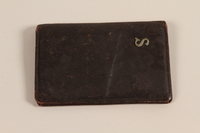
Dark brown leather wallet with metal S used by a Jewish refugee boy
Object
Wallet received by 8 year old Joseph Schadur when he lived in Belgium with his family after escaping Nazi Germany in 1936. Joseph's father, Michel, left Germany in 1935 because the Nazi government's anti-Jewish policies were making it dangerous to live there. His wife, Manja, their 2 children, Joseph and 4 year old Benita, and his mother joined him in Antwerp, Belgium, in January 1936. After the Germans occupied Belgium in May 1940, the family was forced to flee once more. Traveling by private car, they eventually made their way to Lisbon, Portugal. They sailed for New York on board the SS Exeter on February 21, 1941.
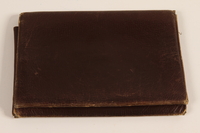
Brown leather billfold used by a Latvian Jewish refugee and aid worker from Nazi Germany
Object
Wallet used by Michel Schadur (later Shadur) in Belgium, France, and Germany during and after the Holocaust. Michel left Germany in 1935 because the Nazi government's anti-Jewish policies were making it dangerous to live there. His wife, Manja, their 2 children, 8 year old Joseph and 4 year old Benita, and his mother joined him in Antwerp, Belgium, in January 1936. After the Germans occupied Belgium in May 1940, the family was forced to flee once more. Traveling by private car, they eventually made their way to Lisbon, Portugal. They sailed for New York on board the SS Exeter on February 21, 1941. In the immediate postwar period, 1945-1947, Michel worked for the United Nations Relief and Rehabilitation Administration (UNRRA) in Germany as a supply officer for the Wurttemberg district and as the director of a displaced persons camp for Jewish refugees.
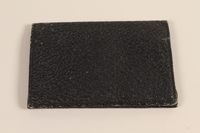
Blue leather billfold used by a Latvian Jewish refugee and aid worker from Nazi Germany
Object
Dark blue leather wallet used by Michel Schadur (later Shadur) in Belgium, France, and Germany during and after the Holocaust. Michel left Germany in 1935 because the Nazi government's anti-Jewish policies were making it dangerous to live there. His wife, Manja, their 2 children, 8 year old Joseph and 4 year old Benita, and his mother joined him in Antwerp, Belgium, in January 1936. After the Germans occupied Belgium in May 1940, the family was forced to flee once more. Traveling by private car, they eventually made their way to Lisbon, Portugal. They sailed for New York on board the SS Exeter on February 21, 1941. In the immediate postwar period, 1945-1947, Michel worked for the United Nations Relief and Rehabilitation Administration (UNRRA) in Germany as a supply officer for the Wurttemberg district and as the director of a displaced persons camp for Jewish refugees.
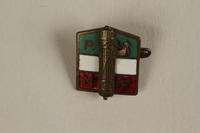
National Fascist Party of Italy (PNF) membership badge owned by Jewish female refugee from Nazi Germany
Object
Partito Nazionale Fascista [National Fascist Party] of Italy lapel pin worn by Gitta Schadur (later Shadur) in the 1930s when she was the only Jewish member of a Fascist group in Berlin, Germany. Gitta had emigrated from Latvia in 1931 and owned a successful exotic fruit and delicacies store in Berlin. Her frequents travels to Italy had led her to become a supporter of Mussolini. Shortly after the Nazis rose to power in Germany in 1933, her store became a target for anti-Semitic protests. Many of her customers felt pressured to stop patronizing a Jewish owned business. After the Kristallnacht pogrom in November 1938, she closed her store, managed to obtain a visa for the United States, and sailed from Belgium on September 2, 1939. Once settled in Minnesota, she was able to help other family members escape Nazi-dominated Europe.
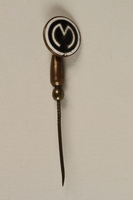
Maccabi Sports Club lapel pin from prewar Berlin owned by a Jewish refugee boy
Object
Lapel pin from a children's Maccabi sports club given to 7 year old Joseph Schadur when he lived in Berlin, Germany, with his family in the 1930s. Joseph's father, Michel, left Germany in 1935 because the Nazi government's anti-Jewish policies were making it dangerous to live there. His wife, Manja, their 2 children, Joseph and his 4 year old sister, Benita, and his mother joined him in Antwerp, Belgium, in January 1936. After the Germans occupied Belgium in May 1940, the family was forced to flee once more. Traveling by private car, they eventually made their way to Lisbon, Portugal. They sailed for New York on board the SS Exeter on February 21, 1941.
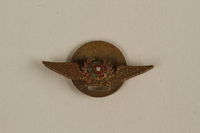
Wing shaped Portuguese Air Force pin given to a young Jewish refugee by friends in Lisbon
Object
Airman's lapel pin given to 13 year old Joseph Schadur by friends in Portugal during his family's flight from Nazi dominated Europe. It was given to him by two brothers, Sebastio and Jose Alameida, who came to the family's aid when they were stranded in Alcobaca during Christmas 1940. The men were air force officers and Joseph believed it was a Portuguese Air Force pin, but it may be an advertisement for an inn frequented by airmen. Joseph's father, Michel, left Germany in 1935 because the Nazi government's anti-Jewish policies were making it dangerous to live there. His wife, Manja, their 2 children, Joseph and his 4 year old sister, Benita, and his mother joined him in Antwerp, Belgium, in January 1936. After the Germans occupied Belgium in May 1940, the family was forced to flee once more. Traveling by private car, they eventually made their way to Lisbon, Portugal. They sailed for New York on board the SS Exeter on February 21, 1941.
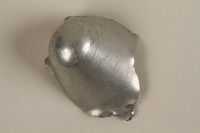
Antiaircraft shell fragments found after an air raid on Bordeaux by a young Jewish refugee
Object
Shell fragments recovered by 12 year old Joseph Schadur in their yard in Bruges, France, during his family's flight from Nazi-dominated Europe. Joseph scratched the date on the fragment himself. The Germans stationed several anti-aircraft batteries in Bruges, a small village near Bordeaux, which was a frequent RAF bombing target because of the port installations.The shells were fired from German guns at British bomber planes over Bordeaux on November 23, 1940. Joseph's father, Michel, left Germany in 1935 because the Nazi government's anti-Jewish policies were making it dangerous to live there. His wife, Manja, their 2 children, Joseph and his 4 year old sister, Benita, and his mother joined him in Antwerp, Belgium, in January 1936. After the Germans occupied Belgium in May 1940, the family was forced to flee once more. Traveling by private car, they eventually made their way to Lisbon, Portugal. They sailed for New York on board the SS Exeter on February 21, 1941.
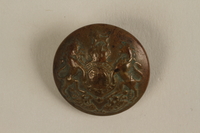
Button from a World War I British military uniform found by a young Jewish refugee in Belgium
Object
Button with the Royal Coat of Arms found by 10 year old old Joseph Schadur in the sand dunes near Oostduinkerke, Belgium, where he and his sister spent summer vacations. The button is from the uniform of a British soldier from the First World War. Joseph's father, Michel, left Germany in 1935 because the Nazi government's anti-Jewish policies were making it dangerous to live there. His wife, Manja, their 2 children, Joseph and his 4 year old sister, Benita, and his mother joined him in Antwerp, Belgium, in January 1936. After the Germans occupied Belgium in May 1940, the family was forced to flee once more. Traveling by private car, they eventually made their way to Lisbon, Portugal. They sailed for New York on board the SS Exeter on February 21, 1941.
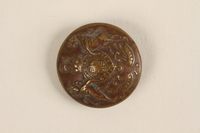
Button from a World War I British military uniform found in the sand by a young Jewish refugee in Belgium
Object
Button with the Royal Coat of Arms found by 10 year old old Joseph Schadur in the sand dunes near Oostduinkerke, Belgium, where he and his sister spent summer vacations. The button is from the uniform of a British soldier from the First World War. Joseph's father, Michel, left Germany in 1935 because the Nazi government's anti-Jewish policies were making it dangerous to live there. His wife, Manja, their 2 children, Joseph and his 4 year old sister, Benita, and his mother joined him in Antwerp, Belgium, in January 1936. After the Germans occupied Belgium in May 1940, the family was forced to flee once more. Traveling by private car, they eventually made their way to Lisbon, Portugal. They sailed for New York on board the SS Exeter on February 21, 1941.
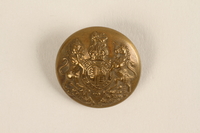
Button from his military uniform given by a British soldier to a young Jewish refugee
Object
Button with the Royal Coat of Arms which a British soldier pulled off his greatcoat and gave to 12 year old old Joseph Schadur on May 16, 1940, in Le Parcq, France. Joseph and his family had just fled Belgium following the Germany invasion.They stopped to consider their route in Le Parcq where they met a large number of British troops. When Joseph's father told one soldier that he was thinking of going toward Dunkirk on the coast, the soldier advised him to go south. He gave him gasoline saying that he did not need it since they were heading across the Channel. Joseph's father, Michel, left Germany in 1935 because the Nazi government's anti-Jewish policies were making it dangerous to live there. His wife, Manja, their 2 children, Joseph and his 4 year old sister, Benita, and his mother joined him in Antwerp, Belgium, in January 1936. After the Germans occupied Belgium in May 1940, the family was forced to flee once more. Traveling by private car, they eventually made their way to Lisbon, Portugal. They sailed for New York on board the SS Exeter on February 21, 1941.
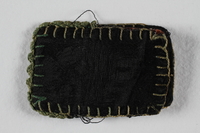
Dip-pen wiper made for a young Jewish refugee from Nazi Germany
Object
Pen cleaning pad made for 11 year old Joseph Schadur by Madame Thorel, the matron of Home Diliges, a vacation boarding house for children in Oostduinkerke, Belgium, where he and his sister stayed during the summer of 1938. Joseph's father, Michel, left Germany in 1935 because the Nazi government's anti-Jewish policies were making it dangerous to live there. His wife, Manja, their 2 children, Joseph and his 4 year old sister, Benita, and his mother joined him in Antwerp, Belgium, in January 1936. After the Germans occupied Belgium in May 1940, the family was forced to flee once more. Traveling by private car, they eventually made their way to Lisbon, Portugal. They sailed for New York on board the SS Exeter on February 21, 1941.

